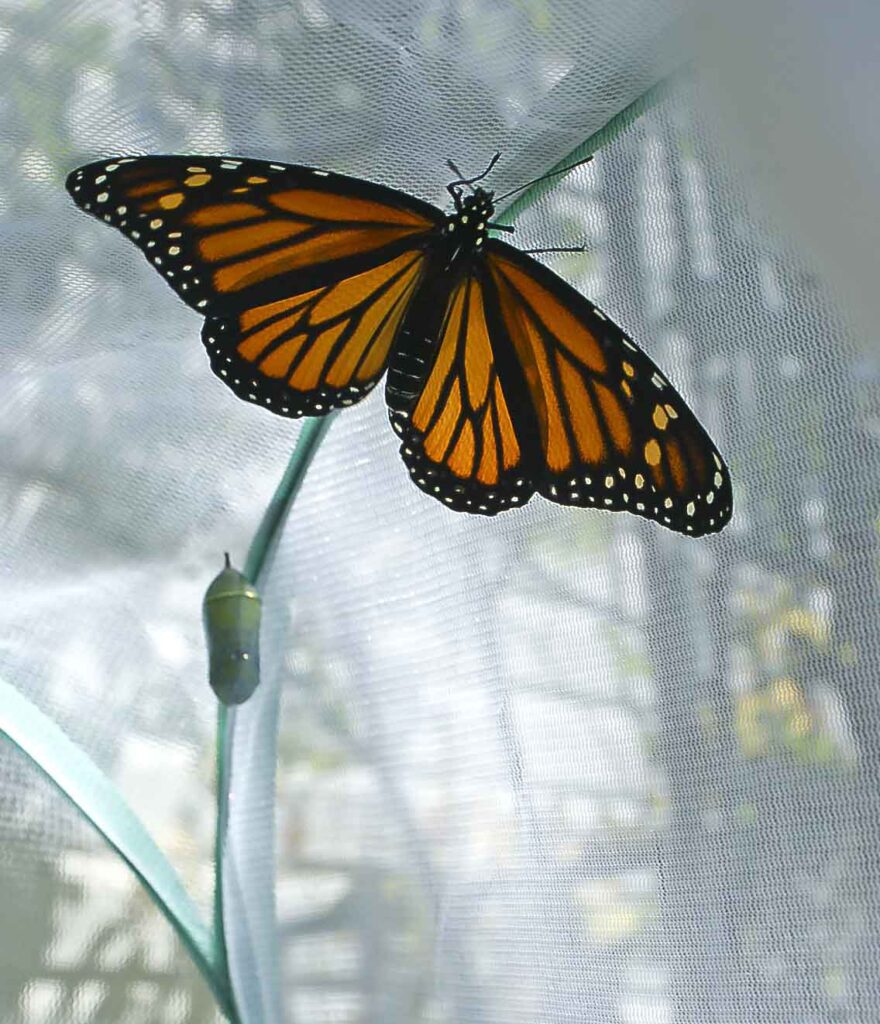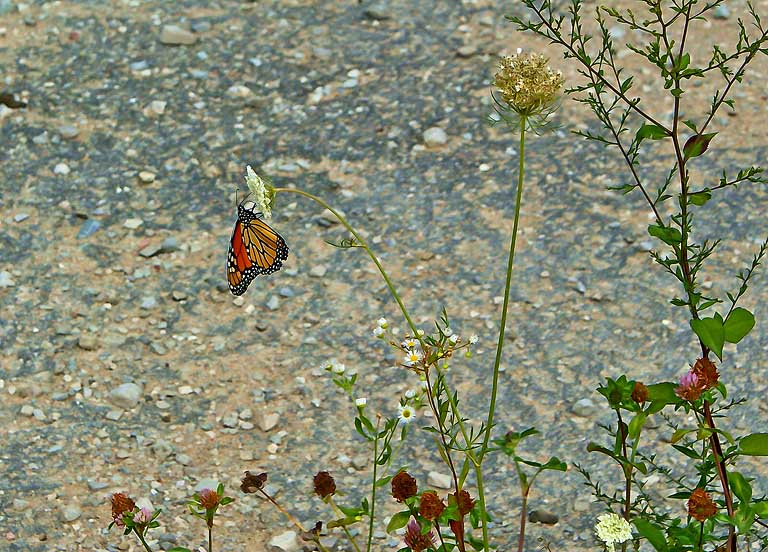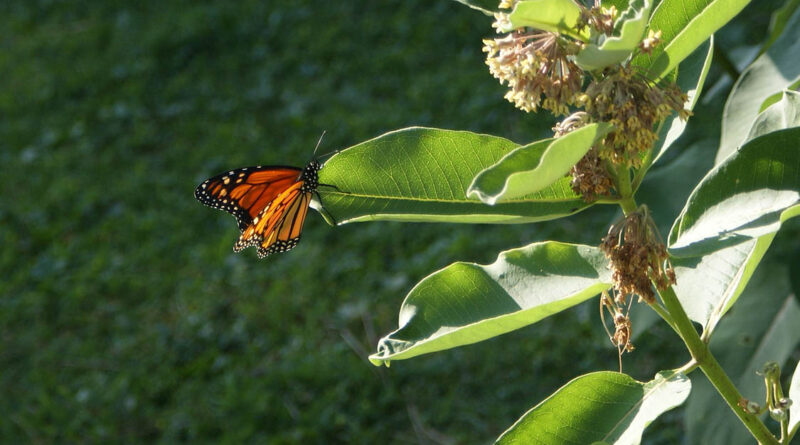Notes From My Backyard – Milkweed
By Susan McTavish
It wasn’t long ago Ontario had milkweed on a noxious weed list. This is a list put out by the ministry of agriculture to control weeds for agricultural purposes. It’s unfortunate it was on the list so many years when many plants were sprayed or removed which would have supported monarchs, as well a host of other insects. I’m not sure why exactly it was taken off the list a few years ago, but can surmise it may have been due to decline of monarchs which need milkweed to reproduce.
I find milkweed to be a fascinating plant. I think of them as being a set for a bug soap opera. Milkweed activity is varied and fascinating. There are different types of milkweed but Common Milkweed is most often found around Orillia.
A few years ago I noticed 3 milkweeds established themselves in my yard. I decided to let them grow and carefully mowed around them. Several years later I have about 24 plants growing in my yard. This is particularly notable because I’m only a few feet away from a busy street. It’s a nice way to have insect activity within a small city.
Many different insects and spiders love milkweed and there is no shortage of drama going on. Monarchs are just one of many species. Milkweed flowers are incredibly fragrant. Some visitors, like the Japanese beetle, can be annoying because they can kill the flowers, arriving in large numbers and hiding about the flowers. Crab spiders blend in quite well with the flowers and will sit in wait for an insect meal. Tussock moth larvae can chew up an entire plant in short order. I often see orange coloured milkweed beetles. The plants also serve as a runway for ants. I see them running up and down stems and leaves seeking out tasty morsels, including monarch eggs.
The first year I let the milkweeds grow I wasn’t expecting monarchs. I joined a group called Monarchs and Milkweed to see what I could learn. I discovered the monarchs were already laying eggs on the underside of my milkweed leaves. The problem was the ants kept eating them. I’d see an egg, then it would be gone within an hour. So I did what many in the group did, I broke away a piece of leaf with eggs on it and put it inside a mesh monarch cage. I kept the leaf from drying with a light spray of water and placed additional leaves as needed.

After hatching, monarch larvae are difficult to see as they are so small. They usually hide under the leaves and chew, alternating with sleep, throughout their growing phase until they look like little fatties as many in the group called them. I had 6 the first year, 3 girls and 3 boys, all successfully morphing into healthy beautiful adults.
A few monarchs managed to make it from egg to adulthood without my intervention. A good indicator of larvae are the chew holes and chewed leaf edges. If you have pristine leaves on your milkweed plants throughout the summer then there’s something off, whether it’s because of sprays, treated plants, etc. A chewed up plant is a good sign when it comes to diversity and milkweed.
Adult monarchs will take nectar off milkweed flowers, but they are also seen on many other flowers. With many insects the larvae and adults will likely need different plants. For example, black swallowtail larvae love dill but the adults feed on many flowers. One of the favourite plants for adult monarchs is the Meadow Blazing Star. Untreated healthy blazing star plants are like magnets for monarchs. The Leacock Museum has a planting of blazing star and monarchs can almost always be found on them in late summer when in flower.

Orillia has many places with common milkweed. Often they can be found on empty lots, park edges, and sides of roads. The problem is these off-the-beaten-track plants are sprayed, or alternatively cut down for neatness, resulting in losing large numbers of monarchs and other insects. I’m not certain if the City of Orillia sprays, but for certain many plants get cut down. If we could delay cutting until after monarch season (October) it could help tremendously, or leave some areas untouched for the entire year. The same goes for empty lots. It would be great if grooming was delayed until October so monarchs could finish out their season along with other insects and birds needing weeds and seeds or nesting spots.
Veteran’s Memorial Park had milkweed designed into a planting bed, but for some reason last year they did not appear to be chewed up by insects. I’m not sure if they are there this year. Whether this had to do with lake winds as deterrent, some form of insect treatment sprayed on the plants, or something wrong with the plants themselves is uncertain.
I learned through the Monarch and Milkweed group some milkweed plants purchased from box stores can be treated and end up killing the very insects one is hoping to attract. Milkweed plants need to come from a reliable source when planting your own. People who allow milkweed to grow will sometimes save seeds to offer to others, ensuring a healthy seed source for new plants. I usually let my pods dry up naturally to allow the seeds to disperse. The dried up pods are quite lovely.
Milkweed is a wonderful source of beauty if one looks at it with the awe it deserves. They are also unsurpassed for teaching children about the wonders of the natural world and the life cycle of insects. It only takes a few plants in your yard and they can be observed on a daily basis.
Whether the bugs, the flowers or the seed pods, a number of our local photographers have made this process the subject of their photos and paintings. A monarch caterpillar chewing a leaf from underside, its head poking through a hole, a bug caught in a crab spider’s grip, a fly imprisoned on a flower (the flowers have been known to trap insect legs), or some other photogenic drama. There is no shortage of subject material.
Milkweed truly is a marvelous plant deserving of respect and admiration and its a most important contributor to biodiversity.
(Photos by Susan McTavish) Main: Monarch Butterfly on a flowering milkweed.

Susan McTavish has a degree in landscape architecture from the University of Guelph, a museum designer and accomplished artist, she does what she can to save birds and bees, and the insects and plants sustaining them, especially the birds.

